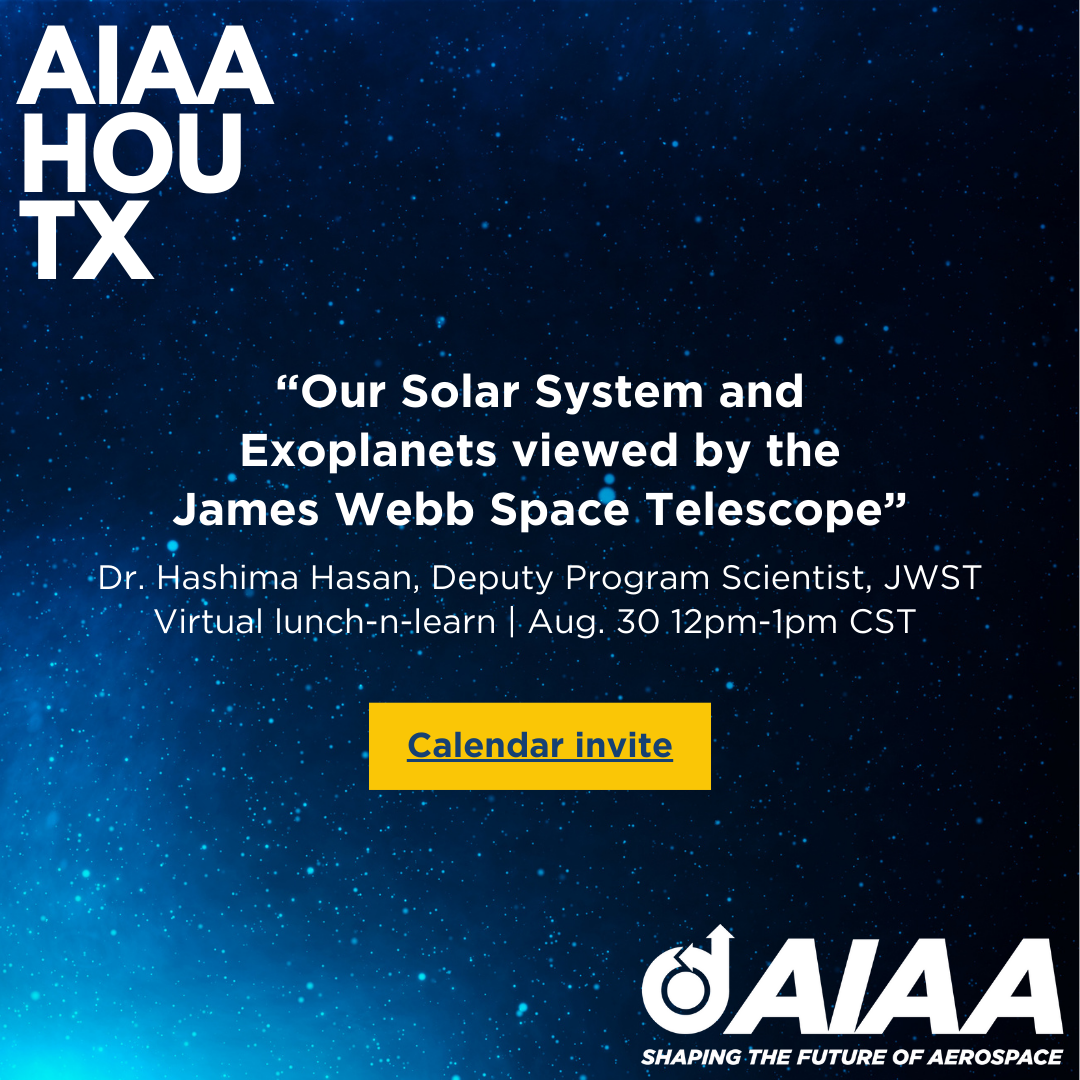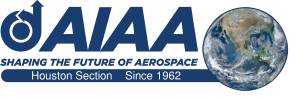Join AIAA Houston Section for a virtual Lunch n Learn event with special guest Dr. Hashima Hasan, Deputy Program Scientist, JWST, this Friday
August
30th, 2024 at 12:00 CST
Join Here


Join AIAA Houston Section for a virtual Lunch n Learn event with special guest Dr. Hashima Hasan, Deputy Program Scientist, JWST, this Friday
August
30th, 2024 at 12:00 CST
Join Here

Jeff Hoblit – Virtual Reality Laboratory/L3 STRATIS – Technical Lead – SAFER Expert
Mr. Hoblit will talk about EVA SAFER System during space walks, or extravehicular activities (EVAs). EVAs are an important part of the assembly & maintenance of the International Space Station (ISS). ISS construction had required more than twice as many space walks as were previously performed in the entire history of spaceflight. Unlike the Space Shuttle, the Space Station cannot maneuver to rescue a free-floating EVA crew members. NASA was determined to make sure that none of space walks ends up like the movie nightmare. One of the ways is by using a Simplified Aid For EVA Rescue (SAFER). Essentially a “life jacket” for space walks. SAFER is a self-contained maneuvering unit worn by astronauts like a backpack. The system relies on small nitrogen-jet thrusters to let an astronaut move around in space. SAFER is a rare type of technology, the kind that is built hoping that it won’t be used. So far, tethers, safety grips, and the robot arm have proved adequate to safely keep astronauts where they are supposed to be during EVAs. But if they ever fail, SAFER will be ready. SAFER is successfully trained at the Virtual Reality Lab/NASA JSC.
The Lunch and Learn with Jeff Hoblit discussing SAFER EVA will be at 11:30am April 29th at Intuitive Machines at 3700 Bay Area Blvd. Houston, TX 77058.
Project Morpheus
NASA’s Morpheus Project has developed and tested a prototype planetary lander capable of vertical takeoff and landing. Designed to serve as a vertical testbed (VTB) for advanced spacecraft technologies, the vehicle provides a platform for bringing technologies from the laboratory into an integrated flight system at relatively low cost. This allows individual technologies to mature into capabilities that can be incorporated into human exploration missions. The Morpheus project and the associated Autonomous Landing and Hazard Avoidance Technology (ALHAT) project provide technological foundations for key components of the greater exploration architecture necessary to move humans beyond low Earth orbit (LEO).
The Lunch and Learn with Dr. Wyatt Johnson discussing Project Morpheus will be at 11:30am April 17th at Intuitive Machines at 3700 Bay Area Blvd. Houston, TX 77058. Registration is below.
Dr. Wyatt Johnson received his doctorate from Purdue University in 2002 in the area of ‘aeroassisted interplanetary trajectory design’. He then worked at JPL from 2002 until 2005 working on various projects, including EDL analysis for the Mars Phoenix Lander. In 2005, Dr. Johnson moved to Houston to work for JSC as a civil servant. His work initially consisted of numerical predictor-corrector skip-entry guidance analysis for Orion, as well an emergency entry guidance option called “loads managed guidance”. In 2010, Dr. Johnson started working on Morpheus, as the sole member of the guidance team. During the first dozen tether flights of 2011, it was noted that the vehicle thrust gimbal response did not match the control command. Other members of the GNC team (Dr Tim Crain and Louis Nguyen) devised a method to measure the offset using a mirror and two lasers. This method confirmed that the gimbal response was the cause of the error, but the data did not suggest a cause. Dr. Johnson came up with a computer vision approach to take measurements of the gimbal pointing error in an attempt to help the team speed up the process. Unfortunately, the first version of the tool was about 15-20x slower than the original hand technique, but the digitally collected data helped Dr. Johnson determine the root cause of the gimbal pointing problem and then to correct for the problem via a least squares batch filter. The filter output was loaded onto the vehicle FSW and the subsequent tether flight showed improved stability.
Event Registration: